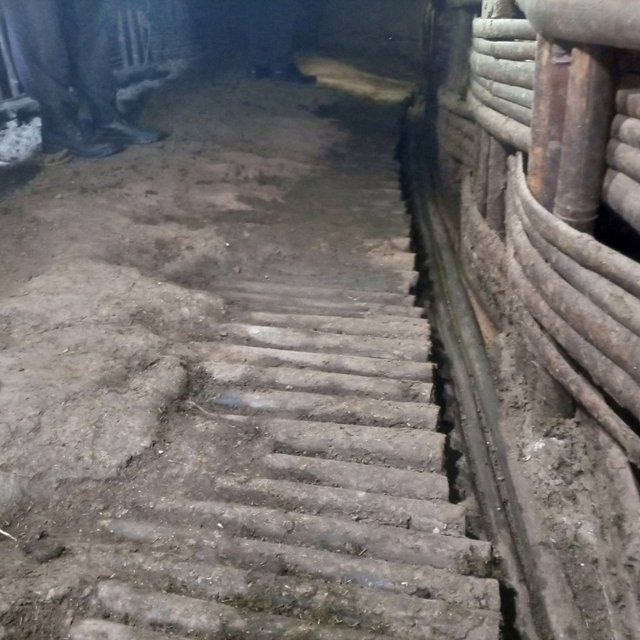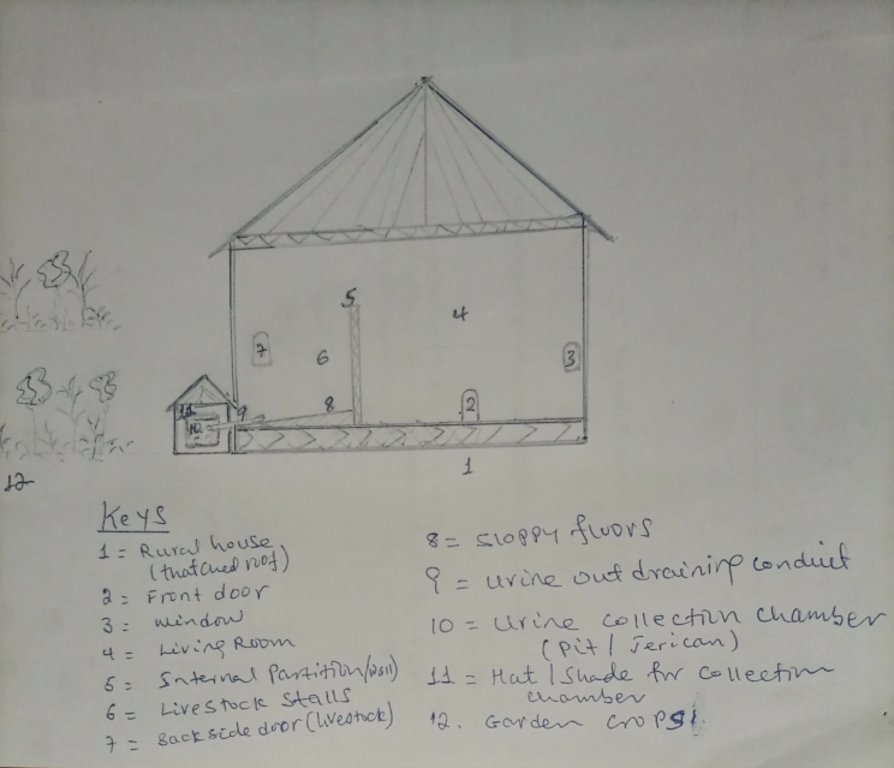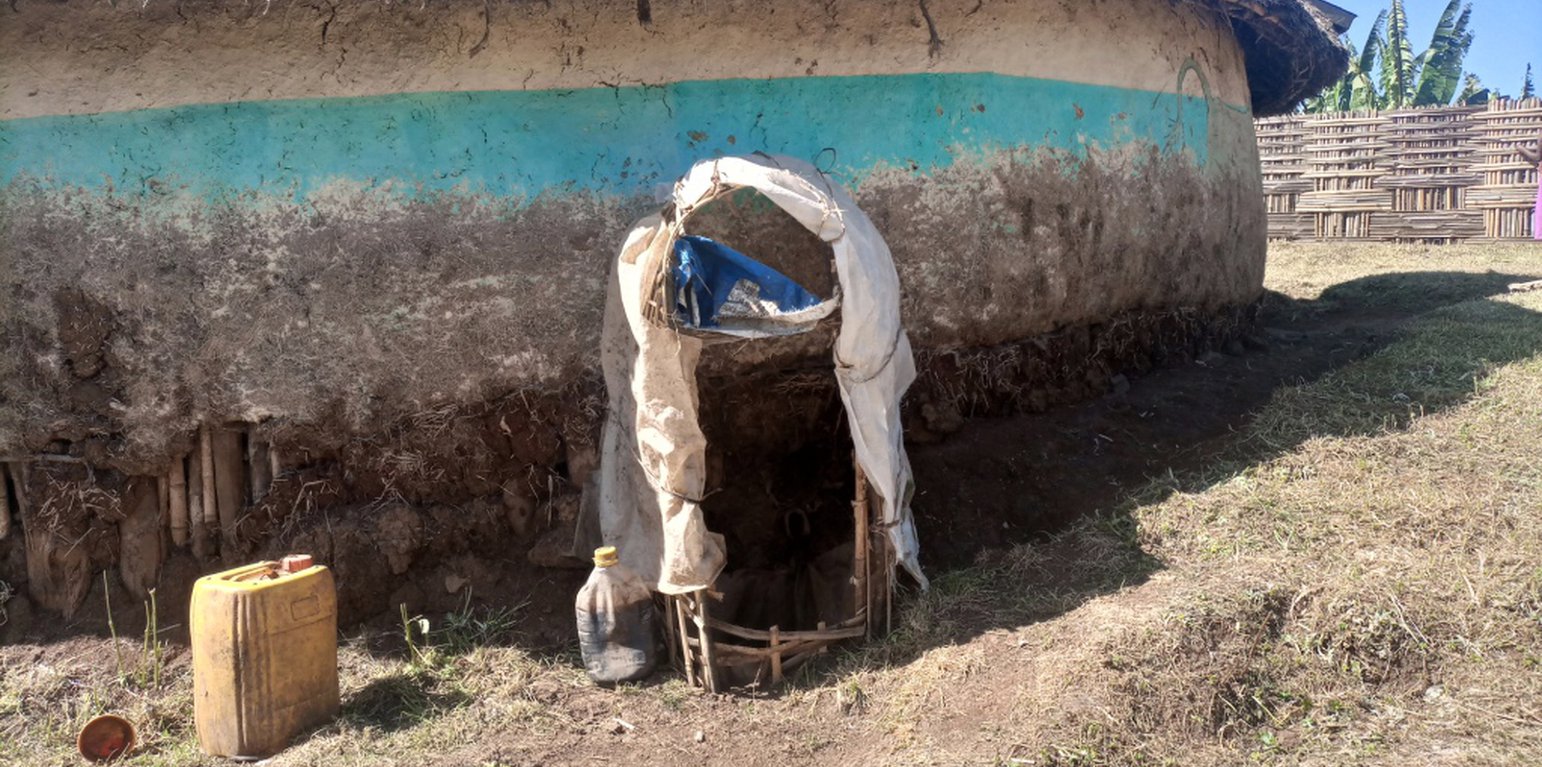Livestock Urine Collection and Use
(Etiópia)
Yeshint Madaberya
Descrição
Collection of livestock urine allows resource-poor farmers to capture nutrient-rich livestock waste and use it to substitute urea fertilizer. It is a liquid organic product that restores soil fertility and pest management.
Enset, the “false banana”, is a perennial that grows well under the supply of organic fertilizers (farmyard manure, urine, compost and other household refuse). In the enset farming system, farmers traditionally shelter their livestock behind a partition within the main house. They construct a sloping floor in the livestock stall to allow the urine to drain into a narrow channel that leads to nearby enset and vegetable plots. However, construction of a collection chamber on the outlet side is an innovative approach which allows for better use of the urine. The collected urine fertilizes annual crops such as barley, maize, and vegetables - notably kale, carrots, and onions, via foliar and basal applications. Land users collect and preserve the urine for about 15 days before applying it to the target crops for the intended purposes. The urine is also used for pest management such as aphids and cutworms. According to the land user interviewed about 20 litres a day can be collected from six cattle. This implies the potential to collect about 7 cubic metres a year by a farmer: a considerable resource that should not be lost when there is an urgent need to restore soil fertility given ongoing and severe problems with land degradation. Therefore, urine collection and storage can be a way of reducing substantial investment in chemical fertilizers. To learn and showcase the benefits of urine as a replacement for urea fertilizer, a farmer sprayed 80 litres of urine twice onto 600 m2 of a ISFM+ barley demonstration plot. The sprayed amount replaced the equivalent of 6 kg urea that currently costs about 300 ETB.
Housing animals enables the collection of a reasonable quantity of urine to restore the soil fertility at the homestead and on the farm. Locally available bamboo helps to construct partitions and stall floors for the livestock as well as serving as a pipeline to drain the urine into a collection chamber. The benefits of applying urine goes beyond simply urea replacement, and its potential is merely limited by land users knowledge, skills, and motivation. These can be acquired via training, demonstration, exchange visit, and social learning. Land users like the role of urine in restoring soil fertility and boosting production. Furthermore, urine serves as integrated pest management via targeted application, deterring insects. However, the smell of the urine is unpleasant and may deter farmers from its use as they do not have safety clothes or masks to use when spraying the crop.
Localização

Localização: Tuticha Kebele 01, Sidama, Etiópia
Nº de sites de tecnologia analisados: Local único
Geo-referência de locais selecionados
Difusão da tecnologia: Aplicado em pontos específicos/concentrado numa pequena área
Em uma área permanentemente protegida?: Não
Data da implementação: 2022
Tipo de introdução
-
atráves de inovação dos usuários da terra
-
Como parte do sistema tradicional (>50 anos)
-
durante experiências/ pesquisa
-
através de projetos/intervenções externas

The floor of the cattle stall drains the urine straight to the collection chamber set outside the house. (Gerba Leta)
Classificação da Tecnologia
Objetivo principal
-
Melhora a produção
-
Reduz, previne, recupera a degradação do solo
-
Preserva ecossistema
-
Protege uma bacia/zonas a jusante – em combinação com outra tecnologia
-
Preservar/melhorar a biodiversidade
-
Reduzir riscos de desastre
-
Adaptar a mudanças climáticas/extremos e seus impactos
-
Atenuar a mudanças climáticas e seus impactos
-
Criar impacto econômico benéfico
-
Cria impacto social benéfico
Uso da terra
Uso do solo misturado dentro da mesma unidade de terra: Não
-
Terra de cultivo
- Cultura anual: culturas forrageiras - gramíneas, cereais - cevada, vegetais - vegetais de folhas (saladas, couve, espinafre, outros), legumes e leguminosas - ervilhas, culturas de raiz/tubérculos- batatas
- Cultura perene (não lenhosa)
Número de estações de cultivo por ano: 2
O cultivo entre culturas é praticado? Não
O rodízio de culturas é praticado? Sim
Abastecimento de água
-
Precipitação natural
-
Misto de precipitação natural-irrigado
-
Irrigação completa
Objetivo relacionado à degradação da terra
-
Prevenir degradação do solo
-
Reduzir a degradação do solo
-
Recuperar/reabilitar solo severamente degradado
-
Adaptar à degradação do solo
-
Não aplicável
Degradação abordada
-
Deteriorização química do solo - Cn: declínio de fertilidade e teor reduzido de matéria orgânica (não causado pela erosão)
-
Degradação biológica - Bq: quantidade/ declínio da biomassa, Bp: aumento de pragas/doenças, perda de predadores
Grupo de GST
-
Gestão integrada plantação-criação de animais
-
Gestão integrada de fertilidade do solo
-
Gestão integrada de pragas e doenças (inclusive agricultura orgânica)
Medidas de GST
-
Medidas agronômicas - A2: Matéria orgânica/fertilidade do solo
-
Medidas de gestão - M7: Outros
Desenho técnico
Especificações técnicas
The urine collection chamber is set up adjacent to the rural house on the side of livestock stalls. It receives urine that drains out of the sloping floor intentionally constructed using stone or bamboo to drain the liquid wastes through conduit directly to the collection chambers. A ditch that is placed adjacent to the outlet also takes the slurry to the nearby farm/garden. The dimension of the collection chamber and the types of materials used to establish the technology varies depending on resource availability or the number of livestock held by the land user. Other materials such as concrete pits or pits lined by google membranes can be used. Furthermore, jerrican or clay pots are the other alternative tools to collect urine. The different local materials replace the use of expensive materials. Small protective caps over the chamber is recommendable to protect the collected urine from rain and the heat of the sun that triggers the volatilization loss of urea. It is also possible to note additional information from the associated keys to describe the sketch.

Author: Gerba Leta
Estabelecimento e manutenção: atividades, insumos e custos
Cálculo de insumos e custos
- Os custos são calculados: Por unidade de tecnologia
- Moeda utilizada para o cálculo de custos: ETB
- Taxa de câmbio (para USD): 1 USD = 53.6283 ETB
- Custo salarial médio da mão-de-obra contratada por dia: 500
Fatores mais importantes que afetam os custos
Economic crisis, spiking inflation, and overall labour and material market cost instability.
Atividades de implantação
-
Construct collection chamber (Periodicidade/frequência: Dry season)
-
Construct hats or covering lid for the chamber/collection pit (Periodicidade/frequência: Dry season)
-
Lining drainage line heading to the pit with concrete (Periodicidade/frequência: Dry season)
-
Storage vessels/barrel (Periodicidade/frequência: Anytime)
-
Supplying safety clothes (wear, boots, gloves and mask) (Periodicidade/frequência: In advance)
Estabelecer insumos e custos
| Especifique a entrada |
Unidade |
Quantidade |
Custos por unidade (ETB) |
Custos totais por entrada (ETB) |
% dos custos arcados pelos usuários da terra |
|
Mão-de-obra
|
| Casual labor |
no. |
4,0 |
250,0 |
1000,0 |
100,0 |
| Carpentering |
no. |
1,0 |
1000,0 |
1000,0 |
50,0 |
|
Equipamento
|
| Safety wears (shirt & trousers, gloves, mask, boots) |
Lump sum |
1,0 |
3000,0 |
3000,0 |
|
| Watering cane |
no. |
1,0 |
1000,0 |
1000,0 |
|
|
Fertilizantes e biocidas
|
| Effective Micro Organism |
Litre |
2,0 |
100,0 |
200,0 |
50,0 |
|
Material de construção
|
| Cement |
kg |
100,0 |
20,0 |
2000,0 |
50,0 |
| Stone |
m3 |
1,0 |
2000,0 |
2000,0 |
100,0 |
| Corrugated iron |
pcs |
2,0 |
1000,0 |
2000,0 |
50,0 |
| Posts and nails |
Lump sum |
1,0 |
1000,0 |
1000,0 |
50,0 |
| Custos totais para a implantação da tecnologia |
13'200.0 |
|
| Custos totais para o estabelecimento da Tecnologia em USD |
246.14 |
|
Atividades de manutenção
-
Effective Microorganisms (Periodicidade/frequência: Throughout collection and application)
Insumos e custos de manutenção
| Especifique a entrada |
Unidade |
Quantidade |
Custos por unidade (ETB) |
Custos totais por entrada (ETB) |
% dos custos arcados pelos usuários da terra |
|
Mão-de-obra
|
| EMO |
Litre |
6,0 |
100,0 |
600,0 |
100,0 |
| Family labor |
no. |
52,0 |
100,0 |
5200,0 |
100,0 |
| Custos totais para a manutenção da tecnologia |
5'800.0 |
|
| Custos totais de manutenção da Tecnologia em USD |
108.15 |
|
Ambiente natural
Média pluviométrica anual
-
<250 mm
-
251-500 mm
-
501-750 mm
-
751-1.000 mm
-
1.001-1.500 mm
-
1.501-2.000 mm
-
2.001-3.000 mm
-
3.001-4.000 mm
-
> 4.000 mm
Zona agroclimática
-
úmido
-
Subúmido
-
Semiárido
-
Árido
Especificações sobre o clima
Receive bimodal rainfall with a summer maximum.
The rainfall distribution is nearly consistent. The temperature is cold typical of highland weather conditions.
Inclinação
-
Plano (0-2%)
-
Suave ondulado (3-5%)
-
Ondulado (6-10%)
-
Moderadamente ondulado (11-15%)
-
Forte ondulado (16-30%)
-
Montanhoso (31-60%)
-
Escarpado (>60%)
Formas de relevo
-
Planalto/planície
-
Cumes
-
Encosta de serra
-
Encosta de morro
-
Sopés
-
Fundos de vale
Altitude
-
0-100 m s.n.m.
-
101-500 m s.n.m.
-
501-1.000 m s.n.m.
-
1.001-1.500 m s.n.m.
-
1.501-2.000 m s.n.m.
-
2.001-2.500 m s.n.m.
-
2.501-3.000 m s.n.m.
-
3.001-4.000 m s.n.m.
-
> 4.000 m s.n.m.
A tecnologia é aplicada em
-
Posições convexas
-
Posições côncavas
-
Não relevante
Profundidade do solo
-
Muito raso (0-20 cm)
-
Raso (21-50 cm)
-
Moderadamente profundo (51-80 cm)
-
Profundo (81-120 cm)
-
Muito profundo (>120 cm)
Textura do solo (superficial)
-
Grosso/fino (arenoso)
-
Médio (limoso, siltoso)
-
Fino/pesado (argila)
Textura do solo (>20 cm abaixo da superfície)
-
Grosso/fino (arenoso)
-
Médio (limoso, siltoso)
-
Fino/pesado (argila)
Teor de matéria orgânica do solo superior
-
Alto (>3%)
-
Médio (1-3%)
-
Baixo (<1%)
Lençol freático
-
Na superfície
-
< 5 m
-
5-50 m
-
> 50 m
Disponibilidade de água de superfície
-
Excesso
-
Bom
-
Médio
-
Precário/nenhum
Qualidade da água (não tratada)
-
Água potável boa
-
Água potável precária (tratamento necessário)
-
apenas para uso agrícola (irrigação)
-
Inutilizável
A qualidade da água refere-se a: tanto de águas subterrâneas quanto de superfície
A salinidade é um problema?
Ocorrência de enchentes
Características dos usuários da terra que utilizam a tecnologia
Orientação de mercado
-
Subsistência (autoabastecimento)
-
misto (subsistência/comercial)
-
Comercial/mercado
Rendimento não agrícola
-
Menos de 10% de toda renda
-
10-50% de toda renda
-
>50% de toda renda
Nível relativo de riqueza
-
Muito pobre
-
Pobre
-
Média
-
Rico
-
Muito rico
Nível de mecanização
-
Trabalho manual
-
Tração animal
-
Mecanizado/motorizado
Sedentário ou nômade
-
Sedentário
-
Semi-nômade
-
Nômade
Indivíduos ou grupos
-
Indivíduo/unidade familiar
-
Grupos/comunidade
-
Cooperativa
-
Empregado (empresa, governo)
Idade
-
Crianças
-
Jovens
-
meia-idade
-
idosos
Área utilizada por residência
-
< 0,5 ha
-
0,5-1 ha
-
1-2 ha
-
2-5 ha
-
5-15 ha
-
15-50 ha
-
50-100 ha
-
100-500 ha
-
500-1.000 ha
-
1.000-10.000 ha
-
> 10.000 ha
Escala
-
Pequena escala
-
Média escala
-
Grande escala
Propriedade da terra
-
Estado
-
Empresa
-
Comunitário/rural
-
Grupo
-
Indivíduo, não intitulado
-
Indivíduo, intitulado
Direitos do uso da terra
-
Acesso livre (não organizado)
-
Comunitário (organizado)
-
Arrendado
-
Indivíduo
Direitos do uso da água
-
Acesso livre (não organizado)
-
Comunitário (organizado)
-
Arrendado
-
Indivíduo
Acesso a serviços e infraestrutura
Emprego (p. ex. não agrícola)
Água potável e saneamento
Comentários
Although they mentioned the quality of both ground and surface water is good in the preceding section, the level of sanitation is not significant as the resident use water from the springs for drink and other household activities.
Impactos
Impactos socioeconômicos
Produção agrícola
Quantidade anterior à GST: 70 kg from 0.12 hectare of land.
Quantidade posterior à GST: 400 kg from the same land.
With the application of ISFM+ approach and urine as a replacement for Urea, a substantial yield increment was achieved.
Qualidade da safra
As the technology is at its early stage of implementation where documentation is not well organized, it was impossible to quantify the harvest and quality of the crop.
Despesas com insumos agrícolas
As urine complement urea fertilizer, other nutrients from Sulfur, Phosphorus and other micro nutrients remain important.
Impactos socioculturais
Segurança alimentar/auto-suficiência
Oportunidades culturais (p. ex. espiritual, estética, outros)
Conhecimento de GST/ degradação da terra
Crop response to urine application is an evidence based for adoption of the SLM technology.
Impactos ecológicos
Matéria orgânica do solo/carbono abaixo do solo
Not practically measured and documented. Besides, the technology is at earlier phase to judge the real impacts.
Biomassa/carbono acima do solo
Controle de praga/doença
It has tangible impacts on managing pests.
Emissão de carbono e gases de efeito estufa
As a foliar application of urine to the target crops might be subjected to evaporation, if not good hours of the day are not identified, there is a likelihood of emission. However, its amount is very insignificant as the little amount used for foliar feeding.
Impactos fora do local
Cheias de jusante (indesejada)
Poluição de água subterrânea/rio
The impact has not yet measured.
Impacto dos gases de efeito estufa
Análise do custo-benefício
Benefícios em relação aos custos de estabelecimento
Retornos a curto prazo
muito negativo
muito positivo
Retornos a longo prazo
muito negativo
muito positivo
Benefícios em relação aos custos de manutenção
Retornos a curto prazo
muito negativo
muito positivo
Retornos a longo prazo
muito negativo
muito positivo
Mudança climática
Mudança climática gradual
Precipitação pluviométrica sazonal redução/diminuição
não bem em absoluto
muito bem
Extremos (desastres) relacionados ao clima
não bem em absoluto
muito bem
Outras consequências relacionadas ao clima
Período de crescimento alogado
não bem em absoluto
muito bem
Período de crescimento reduzido
não bem em absoluto
muito bem
Adoção e adaptação
Porcentagem de usuários de terras na área que adotaram a Tecnologia
-
casos isolados/experimental
-
1-10%
-
11-50%
-
> 50%
De todos aqueles que adotaram a Tecnologia, quantos o fizeram sem receber incentivos materiais?
-
0-10%
-
11-50%
-
51-90%
-
91-100%
Número de residências e/ou área coberta
Forty-four (44) farmers are currently piloting this technology. Of these, 30 farmers are innovative and adopted the technology on their own using locally available materials to collect and spray urine as a complement to urea fertilizer to the target crops.
A tecnologia foi recentemente modificada para adaptar-se as condições variáveis?
A quais condições de mudança?
-
Mudança climática/extremo
-
Mercados dinâmicos
-
Disponibilidade de mão-de-obra (p. ex. devido à migração)
-
Unavailability of the right kits/materials
Land users use locally available materials to collect, store and spray the urine on the target crops. Meaning the concept is introduced in a way it matches or complements conventional uses of livestock wastes to improve the fertility of soil on which Enset, a perennial crop is growing. Otherwise, standard designs or types of materials and safety precautions kits have not been associated with the technology. Despite the unavailability of the necessary kits for the establishment of the technology, farmers forge their mechanisms to collect and use urine. This indicates the innovativeness of the land/technology users.
Conclusões e experiências adquiridas
Pontos fortes: visão do usuário de terra
-
Reduce costs spent on chemical fertilizer.
-
Increase yield per unit of land and land users' income in general. Furthermore, it increases the number of tillers per plant and overall biomass yield.
-
Manage insect pests such as cutworms and aphids.
Pontos fortes: a visão do/a compilador/a ou de outra pessoa capacitada
-
It seems a good substitute for chemical fertilizer, urea. It improves farmers' access to wasted resources without being used.
-
It restores the fertility of the soil and improves production and productivity, and species diversity which improves ecological benefits on top of the high return from the most minor investment in fertilizer.
Pontos fracos/desvantagens/riscos: visão do usuário de terracomo superar
-
Bad smell of the urine when sprayed on the target crops.
By ensuring access to necessary tools. Otherwise, they will not give up on using it since the benefit outweighs the loss.
-
Lack of spraying materials.
If not accessed spraying tools, the farmer committed to using locally forged ones.
Pontos fracos/desvantagens/riscos: a visão do/a compilador/a ou de outra pessoa capacitadacomo superar
-
Stinking of the urine while applying to the crop.
Try to test whether using Effective Micro Organism (EMO) can improve urine smell before using it in the field.
-
Lack of safety wear and associated necessary kits.
Improving access to the necessary materials, knowledge, and skills to use the available resources or materials effectively.
Referências
Editores
-
Kidist Yilma
-
Julia Doldt
-
Noel Templer
-
Tabitha Nekesa
-
Ahmadou Gaye
-
Siagbé Golli
Revisor
-
William Critchley
-
Rima Mekdaschi Studer
-
Sally Bunning
Data da documentação: 21 de Janeiro de 2023
Última atualização: 22 de Abril de 2024
Pessoas capacitadas
-
Wachara Shone - usuário de terra
Descrição completa no banco de dados do WOCAT
A documentação foi facilitada por
Instituição
- Alliance Bioversity and International Center for Tropical Agriculture (Alliance Bioversity-CIAT) - Quênia
Projeto
- Soil protection and rehabilitation for food security (ProSo(i)l)
Referências-chave
-
Use of Cow Urine in the Field of Agriculture. Singh, R. 2022: http://www.pashudhanpraharee.com/use-of-cow-urine-in-the-field-of-agriculture/
-
Utilization of urine waste to produce quality cauliflower. Khanal, A., Shakya , S. M., Shah, S. C., Sharma, M. D. 2011.: https://www.nepjol.info (Free access)
Links para informação relevante que está disponível online
- Nitrogen concentration in the urine of cattle, sheep and deer grazing a common ryegrass/cocksfoot/white clover pasture. Doi.org/10.1080/00288233.2010.499899: https://www.tandfonline.com











